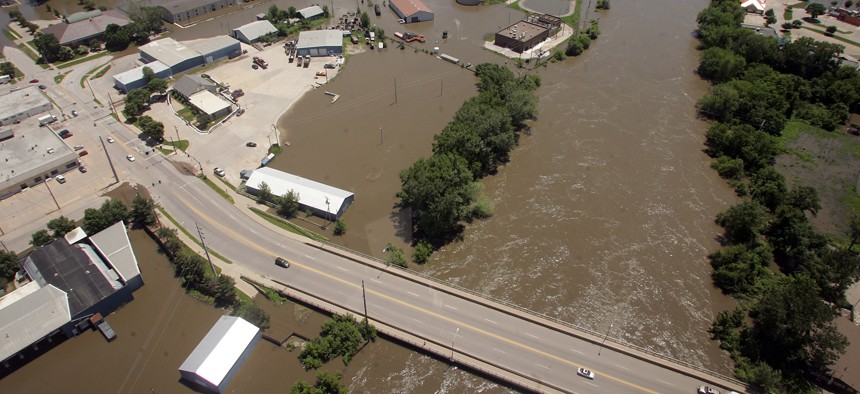More Evidence Pre-Disaster Hazard Mitigation Investments Can Pay Off

A swollen Iowa River flows under the Benton Street bridge in Iowa City, Iowa, on Monday, June 16, 2008. (AP Photo/Hannah van Zutphen-Kann, Pool)
The National Institute of Building Sciences expands on work showing the benefits of mitigation spending far outweigh the costs.
For Iowa City, Dubuque Street is an important corridor, providing an artery for roughly 25,000 vehicles to travel each day between the city and Interstate 80, which runs along the northern edge of town.
But historically the road has been prone to flooding from the nearby Iowa River, which snakes alongside it to the west, as well as flash floods caused by heavy rains. In 1993, floodwaters swamped the street for 54 days. Flooding in 2008 caused a month-long closure.
In recent years, however, Iowa City, home to about 75,700 residents and the University of Iowa, has undertaken a project to raise the roadway by 10 feet, as well as replacing and elevating the Park Road Bridge, which intersects with it and crosses the river.
The project is one of those highlighted in a report out this week from the National Institute of Building Sciences about the potential cost savings from investments in pre-disaster hazard mitigation projects.
Elevating the road and replacing the bridge hasn't been cheap or fast.
It cost around $40 million, with about $18.7 million coming from local general obligation bonds, another $25.8 million from a local sales tax and other funding flowing from the federal government. Melissa Clow, a civil engineer for Iowa City, said when she started working on the project in 2010 the hope was that it could be completed by 2015.
After environmental reviews, planning and design work, construction didn't begin until May of 2016.
"We're wrapping up construction currently," Clow said.
Researchers with NIBS say the project promises to deliver an estimated $456 million in benefit over a 100-year lifespan, meaning it will yield an estimated $11 saved for every $1 of costs.
Most of these benefits, about $432 million, are a dollar-amount representation of the lives that would otherwise be lost due to people drowning while trying to drive through floodwaters.
Benefits and Costs
The new report from the National Institute of Building Sciences is the latest in a body of work the group is producing that attempts to quantify the benefits and costs of pre-disaster mitigation investments.
Back in 2005, it came up with an estimate that every $1 the Federal Emergency Management Agency invested in mitigation activities provided $4 in future benefits. Last year, it took a look at a broader set of federal grants related to natural hazard mitigation and found the ratio was $6 in benefits for every $1 in spending.
The new report looks specifically at hazard mitigation investments in transportation and utility infrastructure.
The research comes during a year when parts of the U.S. have been ravaged by wildfires, hurricanes and flooding, including Hurricane Michael in the Florida panhandle earlier this month.
Last year, the U.S. sustained an estimated $306.2 billion in damages from natural disasters.
"We've seen an increase in the number and cost of disasters," Ryan Colker, vice president of the National Institute of Building Sciences, said as he discussed the institute's latest report on Tuesday.
Data limitations meant the researchers couldn't do reliable statistical analyses for the report. So they instead produced case studies, with benefit-cost ratios, for 12 Economic Development Administration grants. They also studied some other leading options for transportation and utility hazard mitigation projects, which involved upgrades meant to protect infrastructure against earthquakes and wildfires.
Among the findings: four grants for flood mitigation projects for roads and railroads resulted in benefit to cost ratios of 2:1 ($2 saved for every $1 invested) to 11:1 (a fifth grant in this category, for a bridge in New Mexico had a ratio of just 0.2:1). Grants for power line upgrades in Vermont and Texas had benefit-cost ratios of 6:1.
Theoretical improvements to protect water systems, electrical grids and bridges against earthquakes in the Pacific Northwest and California, had benefit to cost ratios of 0.6:1 to 8:1.
Colker noted that when it comes to pre-disaster hazard mitigation and other resiliency efforts, "we still haven't seen the level of investment that you would expect folks to make," given the expected outcomes.
He said the institute has been eyeing policy options for various incentives that could help on this front.
Another example of a specific project that the researchers looked at is a stretch of railway in Coralville, Iowa, that was elevated to keep it above water during flooding. It had the added benefit of serving as barrier between floodwater and nearby buildings.
Estimated benefit-cost ratio for the project over 100 years: $2.05 saved per $1 invested.
Likewise, a grant that supported a $235,000 project in Reedsburg, Wisconsin to move telecommunications and electrical switching equipment to adjacent land that was about 4 feet higher in elevation also has a positive benefit-cost ratio, the report says.
It predicts that over 75 years the project will produce about $2.2 million in benefits, much of it from avoided interruptions to businesses due to flooding. The benefit-cost ratio is pegged at 9 to 1.
Colker said it's important to note that the benefit-cost ratios NIBS has come up with are relatively conservative.
This is partly because there are some benefits that are difficult to quantify in dollar sums, like disruptions to education for children, or loss of family heirlooms or pets, or damaged cultural sites.
Bill Lucia is a Senior Reporter for Government Executive's Route Fifty and is based in Washington, D.C.
NEXT STORY: Can ‘Mad Libs’ Save Our Failing Infrastructure?






